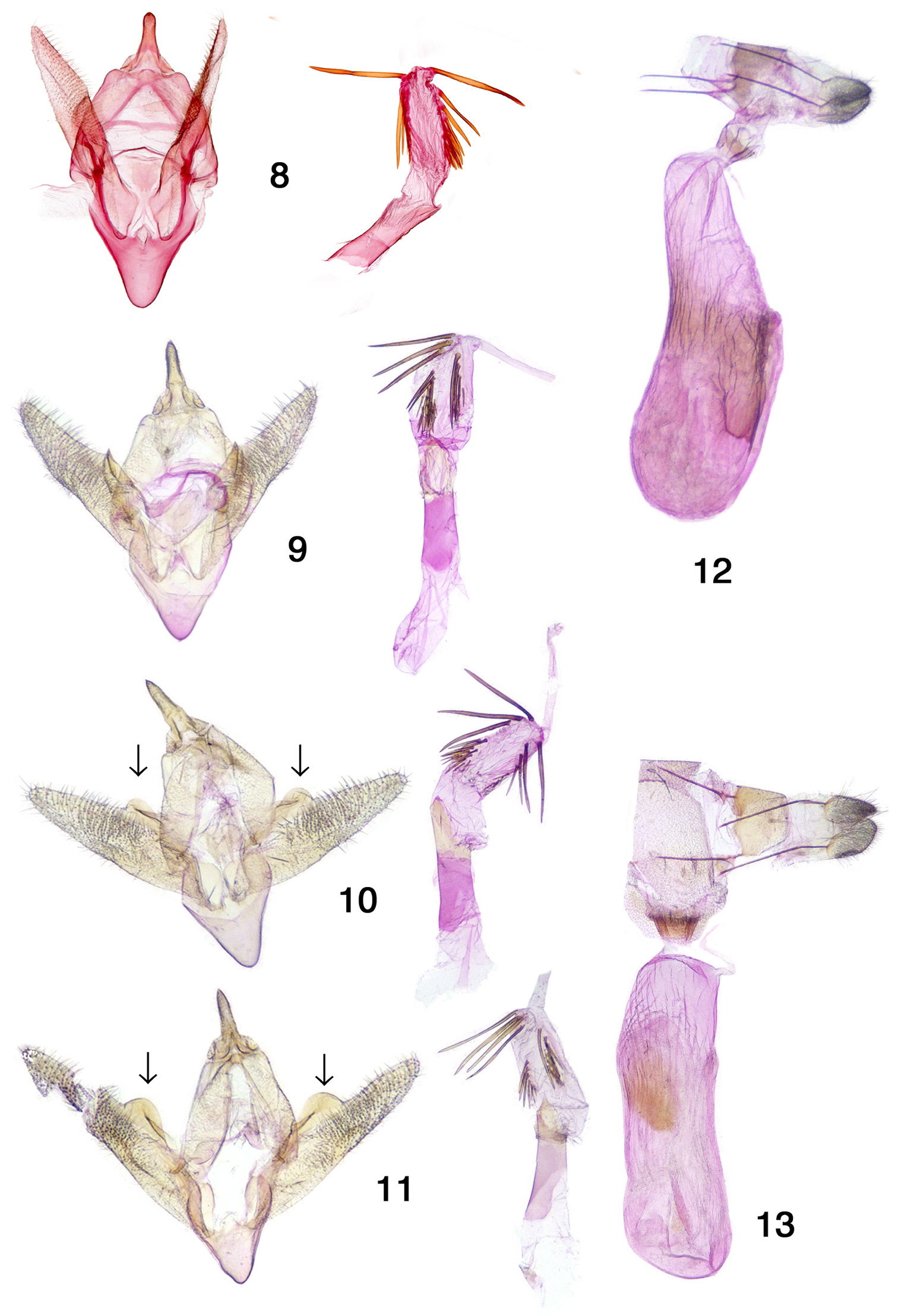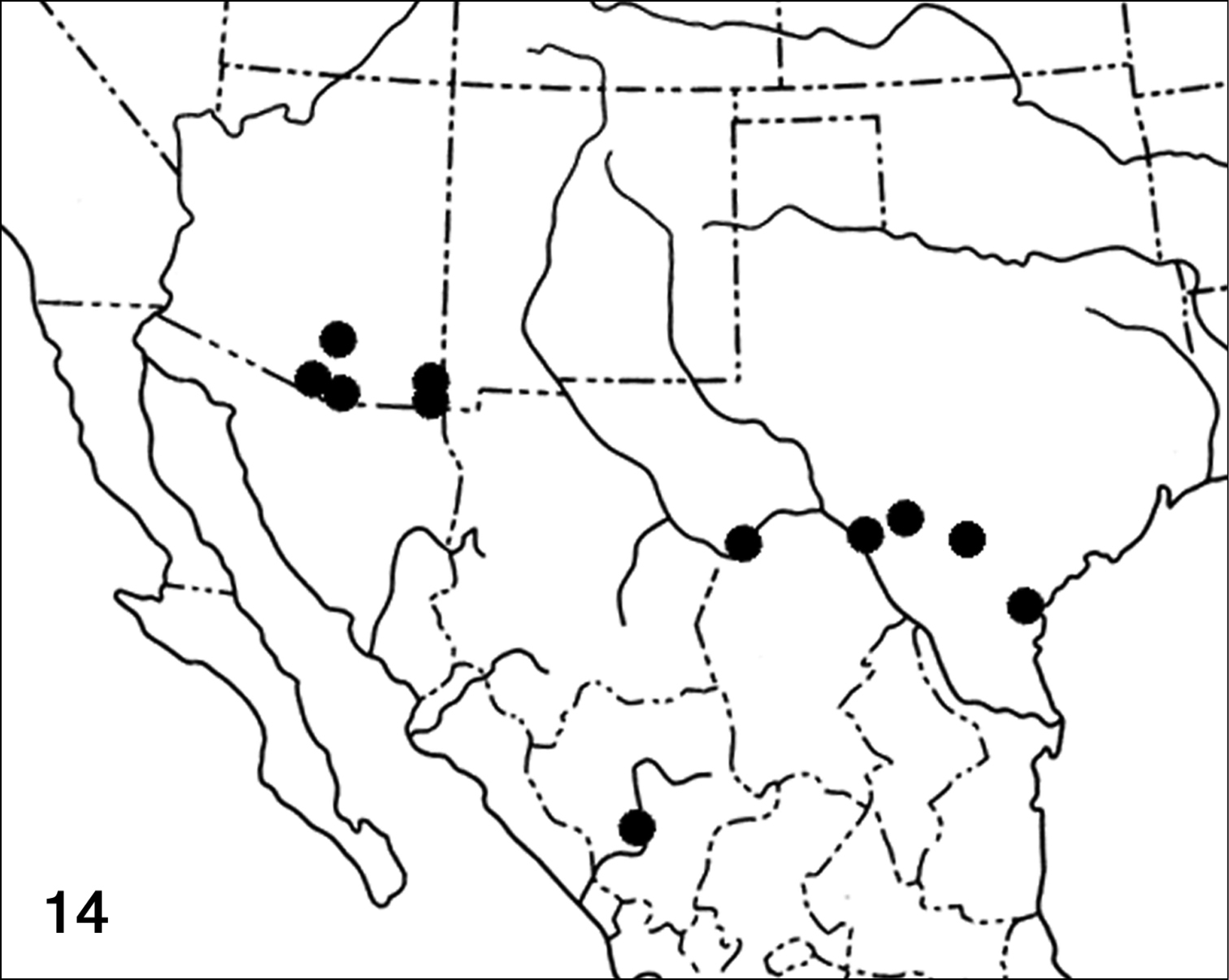






(C) 2011 Clifford D. Ferris. This is an open access article distributed under the terms of the Creative Commons Attribution License, which permits unrestricted use, distribution, and reproduction in any medium, provided the original author and source are credited.
For reference, use of the paginated PDF or printed version of this article is recommended.
Comparison of the types of Ixala klotsi (Sperry) and Pterospoda nigrescens (Hulst) shows that they are the same species, with Ixala klotsi a synonym of Pterospoda nigrescens. A lectotype of Selidosema nigrescens is designated, and the types of Selidosema nigrescens and Ixala klotsi are illustrated. Male and female habitus and genitalia of Pterospoda nigrescens are illustrated.
Arizona, Caberini, Ennominae, Geometridae, Ixala, Lepidoptera, Mexico, nomenclature, Pterospoda, taxonomy, Texas
Repository abbreviations:
AMNH American Museum of Natural History, New York, NY, USA
CNC Canadian National Collection of Insects, Arachnids, and Nematodes, Ottawa, Ontario, Canada
CDF Personal collection of Clifford D. Ferris, Laramie, Wyoming, USA
Systematicshttp://species-id.net/wiki/Pterospoda_nigrescens
Selidosema nigrescens. Female lectotype [here designated], Texas, [Bexar Co.], San Antonio [AMNH] (Fig. 1). A label for the lectotype will be added as follows: “Lectotype / Selidosema / nigrescens Hulst, 1898 / Ferris & Schmidt 2011.” Ixala klotsi. Male holotype, Arizona, [Pima Co.], Baboquivari Mts. 24 April, 1938, Grace H. and John L. Sperry [CNC] (Fig. 2).
Pterospoda nigrescens. 1 Lectotype of Pterospoda nigrescens 2 Holotype of Ixala klotsi 3 male AZ Cochise Co. 4 male AZ Pima Co. 5 male TX Val Verde Co. 6 female AZ Santa Cruz Co. 7 female TX Brewster Co.
USA. Arizona. Cochise Co.: Forest Road 42B, Coronado Nat. For., 1525m , 19.viii.1981, C. D. Ferris (1m); Guadalupe Canyon, 8.viii.1979, C. D. Ferris (1m); Gray Hawk Nature Preserve, 1235 m, 10.ix.2010, C. D. Ferris (1f). Pima Co.: Baboquivari Mtns., 15. iv [no year], S.E. Cassino (2m); Baboquivari Mts., Brown Canyon, 1183 m, 18.viii.2006, C. D. Ferris (1m), 27.vii.2007, C. D. Ferris (8m, 2f); Baboquivari Mtns., Brown Cyn., 22.iv.2006, B. Walsh (3m); 10.vii.2005 (1m); 2.viii.2008, B. C. Schmidt (2m); base of Tortolita Mts., 888 m, all C. D. Ferris, 4–8.iv.2003 (1m, 1f), 27-28.ix.2003 (2m, 2f), 24.x.2003 (1f), 4.x.2004 (1f), 4–11.iv.2005 (1m, 1f), 24.x.05 (1m), 9.x.2006 (1f). Santa Cruz Co., all C. D. Ferris. Patagonia, 1235 m, 8.viii.2009 (1f); Peña Blanca Canyon, 1200 m, 8.ix.2010 (6m, 1f). Texas. Brewster Co. Green Gulch, Big Bend N. P., 6–10.ix.2008 (1f), B[ordelon]/K[nudson]. Sinton Co., Welder Refuge 4.iv.1981 (1f). Uvalde Co., Concan, Neal’s Lodges, 9.iv.1990, N. McFarland (1m, 1f); Concan, 25.iii.1985, E. Knudson (1m). Val Verde Co., Del Rio, 25.iv.1959, M.R. MacKay (1m, 1f), 4.x.1994 (1m), E. Knudson. MEXICO. Durango: 25 mi. W. of Durango, 7500’ 6.v.1961, H. Howden & J.E.H. Martin (1m); 10 mi. W. of Durango, 7500’, 15.v.1964, W.C. McGuffin (1m, 1f); 5 mi. W. of Durango, 6500’ 11.vi.964, J.E.H. Martin (1f).
The type specimen of Selidosema nigrescens in AMNH does not bear a holotype label. Hulst stated in his description: “...all the specimens before me are females.” The specimen label data agree with Hulst’s description, and we therefore consider this specimen to be a syntype. The locations of the other syntypes are unknown. In order to ensure stability of the name, we designate this specimen as the lectotype (Fig. 1). The holotype of Ixala klotsi and additional specimens of Pterospoda nigrescens are illustrated in Figs 1–7.
Genitalia structure (Figs. 8–13). The orientation and degree of flattening of the male genital capsule produces different aspects. The natural position is shown for the holotype of Ixala klotsi (Fig. 8). A partially flattened preparation is shown in Fig. 9, and strongly flattened preparations in Figs 10–11, in which the approximately semicircular projections (indicated by arrows) at the base of the costa become evident. The number and positions of the spines on the everted vesicae are somewhat variable, suggesting that the spines are partially deciduous. The balsam genitalia slide of the female lectotype of Pterospoda nigrescens was made in 1950 without use of stains, and the tissues were strongly cleared. There is very little contrast between the preparation and the now yellowed balsam, and we were unable to obtain a photograph suitable for publication. The form of the genitalia is consistent with specimens from Texas (Fig. 13) and Arizona (Fig. 12). The corpus bursae of the Texas specimen (Fig.13) appears slightly smaller than that of the Arizona specimen (Fig. 12). Upon dissection, it was found to be only partially expanded, and was mechanically manipulated into the position shown.
Ixala Hulst and Pterospoda Dyar were placed in the Caberini along with 11 other genera by
Pterospoda nigrescens occurs at moderate elevations in arid scrub and open woodland habitat, ranging from south-eastern Arizona and the Edwards Plateau of west-central Texas south to at least Durango, Mexico (Fig. 14). It is not known from New Mexico, but should occur there. Collection dates indicate at least two annual flights, primarily in April and August in Arizona. In Pima Co., AZ, Ray Nagle (Tucson, AZ) has reared the moth on a Condalia species, probably Condalia warnockii var. kearneyana M. C. Johnson (Rhamnaceae).
Pterospoda nigrescens genitalia. 8 genitalia of 1 9 genitalia of 4 10 male AZ Pima Co. 11 genitalia of 5 12 female AZ Pima Co. 13 genitalia of 7
Figure 14. Distribution map for Pterospoda nigrescens.
We thank Suzanne Rab Green (AMNH) for photographs and loan of the genitalia slide of Pterospoda nigrescens, and Jocelyn Gill (CNC) for technical support. Bruce Walsh (Tucson, AZ) kindly provided additional specimens and Ed Knudson (Houston, TX) made available Texas material for study. As external reviewers, G. G. Anweiler, Edmonton, AB, and J. B. Sullivan, Beaufort, NC provided helpful suggestions.


